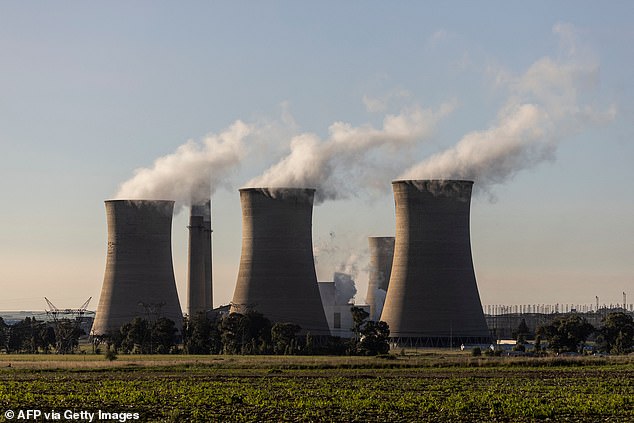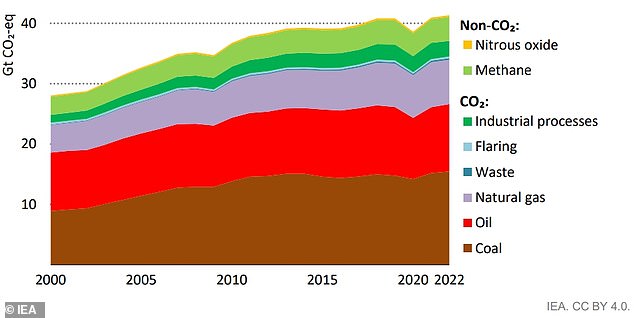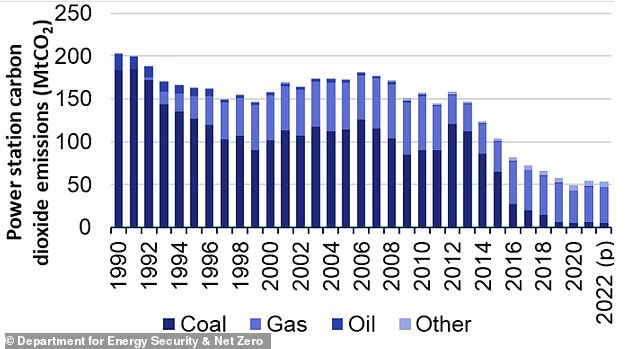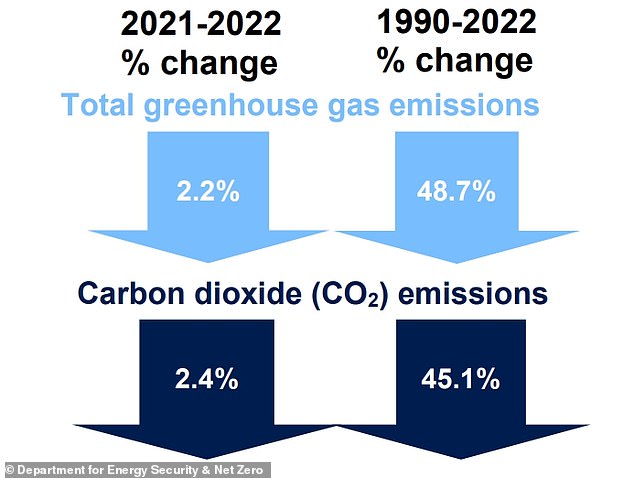Global CO2 emissions are on track to hit an all-time HIGH this year, climate scientists warn
>
Global carbon dioxide emissions are expected to reach all-time highs this year – illustrating the enormous scale of the challenge the world faces in combating climate change.
Scientists say carbon pollution must be cut by almost half this decade if the Paris Agreement is to meet its goal of limiting global warming to 1.5 degrees Celsius (2.7 degrees Fahrenheit) above pre-industrial levels.
They added that carbon dioxide levels should fall by about five percent this year, but are instead expected to rise by up to 1.5 percent, according to preliminary data.
“Emissions will be unlikely to fall in 2023,” Glenn Peters, the scientist behind the research, told AFP.
He added that current projections indicate that carbon dioxide emissions – generated by everything from cars and aircraft to electricity, heating and food production – will increase by between 0.5 percent and 1.5 percent.

Record high: Global carbon dioxide emissions are expected to reach an all-time high this year – illustrating the scale of the challenge the world faces in combating climate change

Warning: “Emissions will be unlikely to fall in 2023,” Glenn Peters, the scientist behind the research, told AFP. This graph shows how carbon dioxide emissions have increased since 1960
“Every year emissions continue to rise, making it more difficult to reach pathways consistent with the Paris Agreement,” said Peters, who is research director at the climate research institute CICERO in Norway.
Its final analysis is due to be published in December before world leaders meet for UN climate talks in the United Arab Emirates.
The discussion on the future use of fossil fuels, which are the main contributor to carbon dioxide pollution, is expected to top the agenda.
However, it’s not all bad news.
The “astonishing” growth of clean energy technologies and electric vehicles means global demand for oil, gas and coal is expected to peak during the current decade, the International Energy Agency (IEA) said earlier this year.
However, the energy watchdog still warns that “stubbornly high emissions” during the post-pandemic economic recovery and the energy crisis caused by the Russian invasion of Ukraine pose a problem for tackling global warming.
Peters said clean energy must begin to replace demand for fossil fuels, but added that “it doesn’t seem to be happening in any meaningful way yet, which is disappointing.”

Breakdown of CO2 emissions: In 2022, emissions from coal alone (15.5 billion tons) were greater than from any other fossil fuel including oil and natural gas.

Brighter results: Despite global forecasts, the UK can still cut greenhouse gas emissions by 2.2 per cent in 2022, according to the Office for National Statistics (pictured)
There was hope that greenhouse gas emissions would peak first in 2015 and then during the Covid-19 pandemic.
However, neither prediction has come true, as carbon dioxide levels are still rising and there is no tipping point in sight.
Scientists have warned that if global temperatures exceed 1.5 degrees Celsius (2.7 degrees Fahrenheit) above pre-industrial levels, it risks triggering a dangerous tipping point in the climate system.
“And yet, here we are again, with a new peak in 2022, and another peak expected again in 2023,” Peters said.
“My concern is that we are doing half the job, which is developing clean energy, and not doing the other half of the job, which is transitioning away from fossil fuels.”
In 2022, carbon dioxide emissions increased by 0.9 percent, or 321 million tons, to reach a new high of 36.8 billion tons, the IEA said.

Reductions: The decline is mainly due to the phase-out of coal power, its replacement by gas, the decline in energy-intensive industries, and the growth of renewable energy.

The UK produced greenhouse gases equivalent to 417 million tonnes of carbon dioxide in 2022
This is largely because many countries returned to using coal during the global energy crisis, although global growth in emissions has been lower than expected.
Coal – which is set to be phased out as an energy source in the UK from 2024 – accounts for more than a third of the world’s total carbon emissions.
Total emissions from coal rose by 1.6 percent, or 243 million tons, last year to reach a new all-time high of about 15.5 billion tons.
Despite these global forecasts, the UK has already managed to reduce greenhouse gas emissions by 2.2% in 2022, according to the Office for National Statistics (ONS).
He explained that the decline was driven by two factors: homes using less fuel for heating due to higher energy prices and warmer weather, so less heat was needed.
The Office for National Statistics added that energy demand has fallen to a level not seen for 50 years.
(Tags for translation)dailymail
